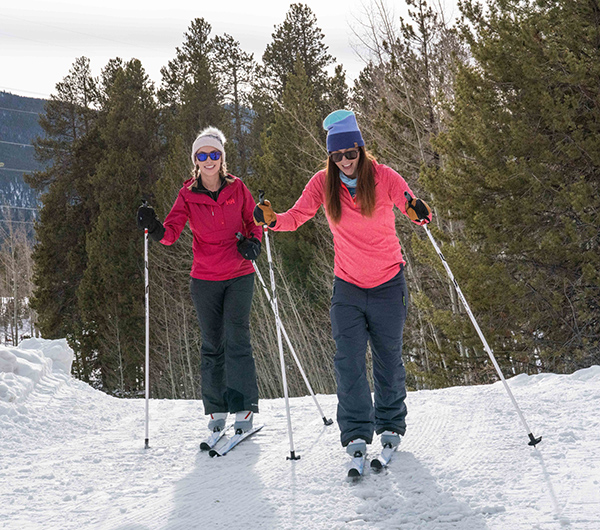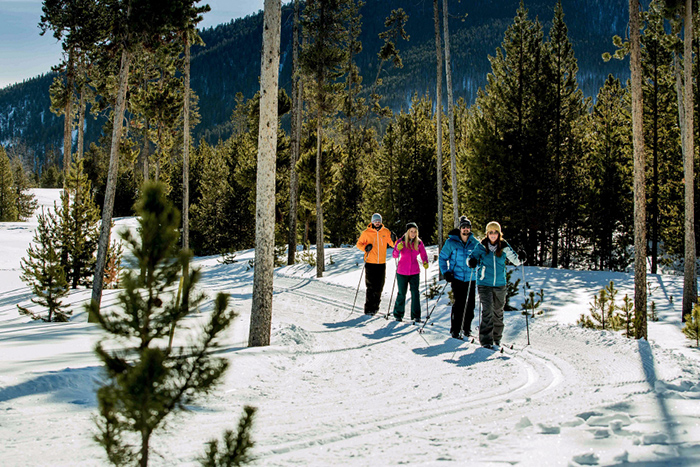By Harper Thomas
Photography Courtesy of Vail Resorts
NORDIC SKIING is a great fitness tool and a wonderful way to experience the state’s beautiful scenery

Nordic skiing began to gain popularity in the United States in the early 20th century, with the establishment of ski clubs and the formation of the National Ski Association in 1905. This era saw an influx of Scandinavian immigrants bringing their skiing traditions. It became more widely recognized in the U.S. with its inclusion in the first Winter Olympics held in Chamonix, France, in 1924.
The 10th Mountain Division* in the Centennial State played a significant role in popularizing skiing. Many veterans of the 10th Mountain Division went on to contribute to the growth of skiing in the civilian sector, including the development of ski resorts and ski schools.
Skate skiing began spreading beyond Scandinavia, where the Finnish military had used it in the ’50s and ’60s, and its adoption increased in other Nordic skiing regions, including North America. Thanks to its dynamic and efficient movements, it garnered attention, offering a faster-paced alternative to classic cross-country skiing.

Both ski techniques are excellent forms of exercise, and why not just pop over to a trailhead near you, strap on your skis and burn some calories?
This form of aerobic exercise significantly enhances cardiovascular fitness and engages large muscle groups, elevating the heart rate and improving overall cardiovascular health. In addition, it works both the upper and lower body simultaneously. The pushing and gliding motions involve the legs, while using poles works the arms, shoulders and core muscles for a comprehensive full-body workout. In addition, it’s low-impact, so it’s easier on your joints than some other aerobic exercises.
Nordic skiing—especially on challenging terrain—helps improve both cardiovascular and muscular endurance simultaneously. Balance and coordinated movements engage your core, improving stability and strength in the abdominal and back muscles. Last but not least, getting outdoors will positively affect your mental health and well-being. The meditative aspect of gliding through snow-covered landscapes can reduce stress and boost your mood. So, grab your skis, head to the nearest trail, and engage in one of the more peaceful and healthful ways to improve your fitness.
Where to Go
The south metro has several parks with trails perfect for getting your Nordic ski on!
Chatfield State Park
Trails may be groomed in winter, but checking with the park office for current conditions is advisable.
Deer Creek Canyon Park
The terrain can be challenging in some areas, so it’s suitable for those with intermediate skill levels.
South Valley Park
Part of the Jeffco Open Space system, this park is known for its red rock formations and offers a picturesque skiing backdrop.
High Line Canal Trail
While the trail is primarily a recreational trail for walking and biking, it can be suitable for cross-country skiing in snowy conditions. Caution: It can be busy, so be alert.
Roxborough State Park
Like South Valley Park, Roxborough is known for its unique red rock formations—the perfect setting for meditative exercise.

Know Before You Go
If you’re new to the sport, head to your favorite outfitter for skis, boots, bindings and poles. In addition, you should grab wax and waxing tools to keep your skis gliding smoothly. You should also:
Dress in layers. Most Coloradans know how to do this, but if you’re new to the state or winter sports, be sure your base layer is moisture-wicking under your insulating layer. Consider a windproof outer shell if you’ll be on wide-open trails or the temps will be low. Hat, gloves, sunglasses—of course.
Bring a small backpack for water, snacks, personal items and a place to stash your layers should you need to shed some. Throw in a small first aid kit and your cell phone in case of an emergency. If you’re unfamiliar with the territory, take a trail map, as some trail areas may not have cell service.
Get a groomed trail pass. If you’re going to ski the Nordic trails—especially at Colorado ski resorts, you may need a pass. Check before you go.
Learn the skills. If you’re unsure about technique, Nordic lessons are available. Better to be safe and comfortable than sorry!
*Read more about the 10th Mountain Division here.



